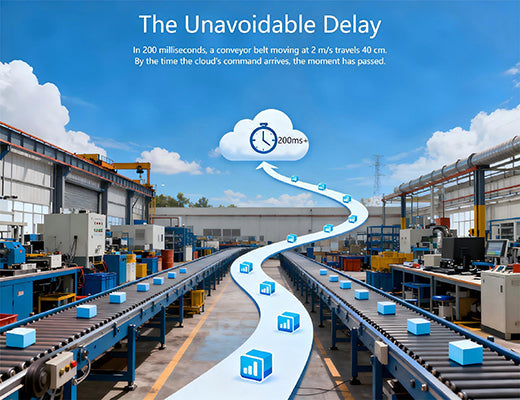
Edge Control vs. Cloud Control: Why Latency is the Deciding Factor
|
|
Time to read 5 min
|
|
Time to read 5 min
The debate between Edge Control vs. Cloud Control is not a matter of preference; it's a matter of physics. This guide explains why network latency—the unavoidable delay of sending data to a distant cloud and back—makes cloud-based control unsuitable for any application that requires a real-time response. We'll break down the "latency budget" and show why edge control, which performs the entire "sense-decide-act" loop locally in milliseconds, is the only viable architecture for high-speed, mission-critical industrial automation.
Cloud Control is powerful but slow. The round-trip time to a cloud data center introduces hundreds of milliseconds of latency, which is an eternity on a factory floor.
Edge Control is fast and autonomous. It makes decisions locally, reducing latency to a few milliseconds and ensuring the system can run even if the internet fails.
The choice is not emotional; it's mathematical. If your process's required reaction time is less than the round-trip latency to the cloud, you must use edge control.
The optimal architecture is often a hybrid model: use edge control for all time-critical tasks and use the cloud for supervision, data storage, and model training.
I was in a design review for a new automated warehouse system. The plan was to use cameras to guide robotic arms that would pick items from a fast-moving conveyor belt. One of the cloud architects on the team proposed a seemingly elegant solution: "Let's stream all the camera feeds to our powerful AI servers in the cloud. The cloud will identify the items and tell the robots when to pick."
I asked one simple question: "What's our round-trip latency to the cloud?" The answer was about 200 milliseconds. "And how fast is the conveyor belt moving?" Two meters per second. A quick calculation showed that in the time it would take to get a command back from the cloud, the item would have already moved 40 centimeters past the robot. The plan was physically impossible.
Let's be clear: this scenario perfectly illustrates the fundamental, non-negotiable difference between Edge Control vs. Cloud Control. The deciding factor isn't processing power; it's the speed of light.

Every real-time control process has a "latency budget." This is the maximum acceptable delay between an event happening and the system physically reacting to it.
The 'aha!' moment for any architect is when they compare this budget to the unavoidable reality of network latency, also known as Round-Trip Time (RTT).
A cloud control architecture looks like this: Sense -> Transmit to Cloud -> Process in Cloud -> Transmit from Cloud -> Act
The "Transmit" steps are the killers. Even with a perfect 5G connection, the physical distance to the nearest cloud data center introduces a delay of tens to hundreds of milliseconds. This latency is unpredictable and cannot be eliminated. For any process with a tight latency budget, cloud control is simply too slow.
An edge control architecture eliminates the two longest and most unpredictable steps: Sense -> Process at Edge -> Act
By placing a powerful edge gateway like the Robustel EG5120 directly on the machine, the entire loop happens on a local network. The network latency is reduced to 1-2 milliseconds, and the total reaction time is dominated by the gateway's processing speed. This is how you achieve the sub-50-millisecond response times required for true real-time automation.

The optimal architecture isn't about choosing one over the other; it's about assigning them the right jobs.
This hybrid model gives you the real-time speed of the edge and the immense analytical power of the cloud, working in perfect synergy.

The decision between Edge Control vs. Cloud Control is one of the most fundamental choices in modern automation design. But it's not a choice you make based on preference. It's a choice dictated by the physics of your application.
By calculating your latency budget and understanding the unavoidable delays of a cloud-based approach, the answer becomes clear. For any application where "right now" truly means right now, edge control is not just the better option—it's the only option.
Further Reading:
A1: 5G dramatically reduces the latency of the "last mile" of the network (from the device to the cell tower). However, it cannot eliminate the latency caused by the physical distance from the cell tower to the cloud data center, which is often the largest part of the delay. While 5G helps, for many high-speed applications, edge control will still be a necessity.
A2: Jitter is the variation in latency. A cloud connection might have an average latency of 100ms, but sometimes it's 80ms, and sometimes it's 150ms. This unpredictability (jitter) is a nightmare for a control system that requires a deterministic, repeatable response time. An edge control loop, being on a local network, has virtually zero jitter.
A3: Cloud control is excellent for processes with a very loose latency budget where a delay of several seconds or even minutes is acceptable. Examples include adjusting the thermostat setpoint for an entire building based on weather forecasts, optimizing the charging schedule for a fleet of electric vehicles overnight, or running a weekly inventory analysis.